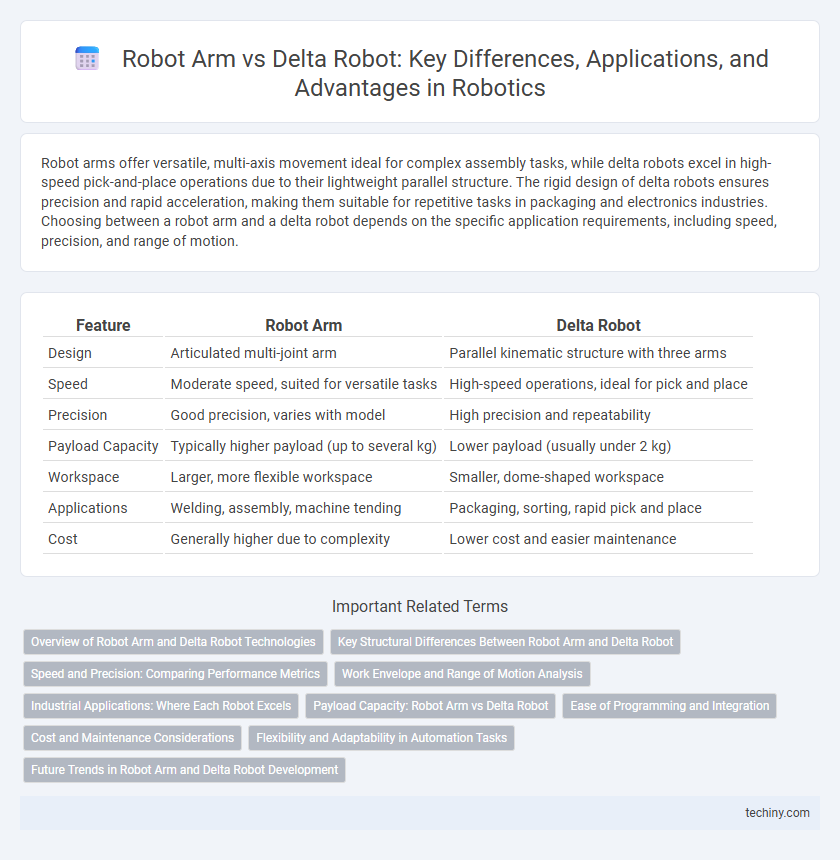Robot arms offer versatile, multi-axis movement ideal for complex assembly tasks, while delta robots excel in high-speed pick-and-place operations due to their lightweight parallel structure. The rigid design of delta robots ensures precision and rapid acceleration, making them suitable for repetitive tasks in packaging and electronics industries. Choosing between a robot arm and a delta robot depends on the specific application requirements, including speed, precision, and range of motion.
Table of Comparison
| Feature | Robot Arm | Delta Robot |
|---|---|---|
| Design | Articulated multi-joint arm | Parallel kinematic structure with three arms |
| Speed | Moderate speed, suited for versatile tasks | High-speed operations, ideal for pick and place |
| Precision | Good precision, varies with model | High precision and repeatability |
| Payload Capacity | Typically higher payload (up to several kg) | Lower payload (usually under 2 kg) |
| Workspace | Larger, more flexible workspace | Smaller, dome-shaped workspace |
| Applications | Welding, assembly, machine tending | Packaging, sorting, rapid pick and place |
| Cost | Generally higher due to complexity | Lower cost and easier maintenance |
Overview of Robot Arm and Delta Robot Technologies
Robot arms utilize articulated joints and multiple degrees of freedom to perform complex, precise tasks in manufacturing, assembly, and material handling, offering versatile motion control and adaptability. Delta robots feature parallel kinematic structures with high-speed, lightweight arms optimized for rapid pick-and-place operations, particularly in packaging and sorting industries. Both technologies leverage advanced sensors and control algorithms to enhance accuracy, repeatability, and efficiency in automation processes.
Key Structural Differences Between Robot Arm and Delta Robot
Robot arms typically feature articulated joints allowing multiple degrees of freedom, which provide versatile movement and high payload capacity suitable for complex tasks. Delta robots use parallel link mechanisms with three lightweight arms connected to a fixed base, optimizing high-speed, precise, and repetitive pick-and-place operations with limited payloads. The key structural difference lies in the serial kinematics of robot arms versus the parallel kinematics of delta robots, impacting their range of motion, speed, and application efficiency.
Speed and Precision: Comparing Performance Metrics
Robot arms typically offer higher precision due to their articulated joints and advanced control systems, enabling intricate tasks requiring fine manipulation. Delta robots excel in speed with their lightweight parallel link design, achieving rapid pick-and-place operations in manufacturing environments. Comparing performance metrics reveals that delta robots outperform in cycle time, while traditional robot arms provide superior accuracy for complex assembly processes.
Work Envelope and Range of Motion Analysis
Robot arms typically offer a larger and more flexible work envelope compared to delta robots, enabling them to perform complex tasks that require extensive reach and multi-axis movement. Delta robots excel in high-speed pick-and-place operations within a smaller, dome-shaped work envelope due to their parallel kinematic structure allowing precise and rapid movements. Analyzing range of motion reveals robot arms provide greater rotational freedom and multi-directional articulation, whereas delta robots prioritize speed and accuracy within a limited spatial range.
Industrial Applications: Where Each Robot Excels
Robot arms excel in industrial applications requiring precision assembly, welding, and material handling due to their versatility and range of motion. Delta robots outperform in high-speed pick-and-place tasks, especially in packaging and pharmaceuticals, because of their lightweight, parallel arm design. Each robot type is optimized for different production demands, with robot arms suited for complex manipulation and delta robots ideal for rapid, repetitive operations.
Payload Capacity: Robot Arm vs Delta Robot
Robot arms typically offer higher payload capacities, ranging from a few kilograms up to several hundred kilograms, making them suitable for heavy-duty industrial applications. Delta robots, designed for high-speed pick-and-place tasks, usually handle lighter payloads between 0.5 to 5 kilograms due to their parallel kinematic structure. The choice between robot arm and delta robot depends heavily on the required payload capacity and operational speed for specific manufacturing processes.
Ease of Programming and Integration
Robot arms offer greater ease of programming and integration due to their widespread use, standardized control interfaces, and extensive software support, enabling seamless adaptation to diverse tasks. Delta robots typically require more specialized programming and integration efforts, as their unique parallel kinematic structure demands custom calibration and specialized software tools. The choice between the two hinges on the complexity of the application and the available programming expertise.
Cost and Maintenance Considerations
Robot arms typically involve higher initial costs due to complex mechanical structures and require regular maintenance for joints, motors, and sensors to ensure precision and longevity. Delta robots generally offer lower maintenance expenses with a simpler design and fewer moving parts, making them cost-effective for high-speed, repetitive tasks. Choosing between these robots depends on budget constraints and the intended application's maintenance capabilities.
Flexibility and Adaptability in Automation Tasks
Robot arms offer superior flexibility and adaptability in automation tasks due to their multi-axis range of motion, allowing precise manipulation in complex environments. Delta robots excel in high-speed, repetitive pick-and-place operations but are limited in handling diverse tasks that require varied orientations and object types. For applications demanding dynamic and versatile automation, traditional robot arms provide enhanced programmability and broader tool compatibility.
Future Trends in Robot Arm and Delta Robot Development
Future trends in robot arm and delta robot development emphasize enhanced precision, speed, and adaptability through advanced AI integration and machine learning algorithms. Lightweight materials and modular designs are driving increased flexibility in applications ranging from assembly lines to medical robotics. Enhanced sensor fusion and real-time data processing are enabling more efficient, collaborative human-robot interactions in dynamic environments.
Robot arm vs delta robot Infographic

 techiny.com
techiny.com